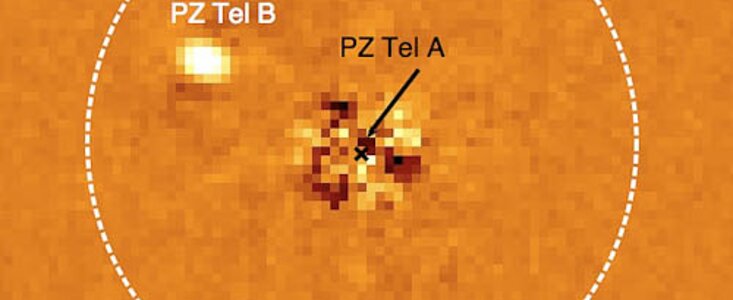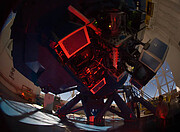Brown Dwarf Careens Around a Young Solar Analogue
23 July 2010
Using the Near-Infrared Coronagraphic Imager (NICI) on the Gemini-South telescope in Chile, an international team led by University of Hawai‘i astronomers Beth Biller and Michael Liu have directly imaged a brown dwarf in a tight orbit around a young Sun-like star. This discovery is a rare find, as the 36 Jupiter-mass brown dwarf companion (dubbed "PZ Tel B" for "PZ Telescopii B") resides only 18 Astronomical Units (AU) from its primary star, similar to the distance of Uranus from the Sun.
Most young brown dwarf and planetary companions found by direct imaging are at orbital separations greater than 50 AU – larger than the orbit of Pluto (~40 AU) from the Sun. In the past year, the researchers observed PZ Tel B moving quickly outward from its parent star. However, as recently as 2003 PZ Tel B was undetectable due to its close proximity to its parent star, indicating its orbit is more elliptical than circular.
Lead author Beth Biller says, "PZ Tel B has a particularly eccentric orbit – in the last 10 years, we have literally watched it careen through its inner solar system. This can best be explained by a highly eccentric (oval-shaped) orbit."
The host star, PZ Tel A, is a younger version of the Sun, having a similar mass but a very young age of only about 12 million years (compared with the approximately 4.6 billion year age of our Sun). In fact, PZ Tel is young enough to still possess significant amounts of cold circumstellar dust, which may have been sculpted by the gravitational interaction with the young brown dwarf companion. This is the material that can form planets so the PZ Tel system is an important laboratory for studying the early stages of planetary system formation. With an estimated mass of 36 times that of Jupiter, PZ Tel B's orbital motion has significant implications for the types of planets that can form (and whether planets can form at all) in the PZ Tel system and perhaps others like it.
PZ Tel B was discovered using NICI, a powerful high contrast instrument designed for imaging brown dwarfs and extrasolar planets around other stars. The Gemini NICI Planet-Finding Campaign, with members drawn from across the Gemini Observatory community, is currently carrying out a 300-star survey with NICI, the largest high-contrast imaging survey ever conducted anywhere to date. Note: see a list of team members at the end of this feature.
NICI Campaign leader Michael Liu says, "We are just beginning to glean the many configurations of solar systems around stars like the Sun. The unique capabilities of NICI provide us a powerful tool for studying their constituents using direct imaging."
Because PZ Tel B is so close to its parent star, special techniques are necessary to detect the faint light of the companion from the light of the primary star. PZ Tel B is separated by less than 0.4" from PZ Tel A, equivalent to the diameter of a dime seen at a distance of 5 miles (~8 kilometers). In order to take direct images so close to the star, the team used an adaptive optics system, to remove atmospheric distortions, coupled to a coronagraph, which blocks out excess starlight, and then applied techniques called Angular and Spectral Differential Imaging (see sidebar). Combining these techniques allowed the detection of PZ Tel B and the measurement of its orbital motion. NICI is the highest contrast camera in operation today and can detect companions 1 million times fainter than the host star at just 1 arcsecond separations. For more information on the imaging techniques used to make this discovery see the NICI instrument page.
NICI Campaign Science Team
The NICI Campaign Science Team was selected in January of 2006.The Gemini Director, with input from the international time allocation committee and a panel of independent experts, chose an international team led by Dr. Michael Liu of the Institute for Astronomy at the University of Hawaii. The team includes members of the instrument group that built NICI and a number of other collaborators from across the Gemini partnership. With strong observational, technical, and theoretical expertise, Gemini expects that the NICI Campaign will significantly advance our understanding of the properties and frequencies of extrasolar planets.
The NICI Campaign team includes: Michael Liu, PI, Mark Chun, co-PI (University of Hawaii), Laird Close, co-PI (University of Arizona), Doug Toomey (Mauna Kea Infrared), Christ Ftaclas, Zahed Wahhaj, Beth Biller, Evgenya Shkolnik (DTM, Carnegie Institution of Washington), Adam Burrows (Princeton University), Neill Reid (STScI), Niranjan Thatte, Matthias Tecza, Fraser Clarke (University of Oxford), Jane Gregorio Hetem, Elisabete De Gouveia Dal Pino (University of Sao Paolo), Silvia Alencar (University of Minas Gerais), Pawel Artymowicz (University of Toronto), Doug Lin (University of California Santa Cruz), Shigeru Ida (Tokyo Institute of Technology), Alan Boss (DTM, Carnegie Institution of Washington), Mark Kuchner (NASA Goddard), Tom Hayward, Markus Hartung (Gemini Observatory), Eric Nielsen, Jared Males, Andy Skemer (University of Arizona).
Angular and Spectral Differential Imaging
The NICI Campaign uses specialized observing strategies to exploit the unique capabilities of the NICI instrument. Angular Differential Imaging (ADI) and Spectral Differential Image (SDI) achieve similar goals by different means – specifically, each technique separates point-like speckles created by telescope and instrument aberrations from true faint companions. For ADI, the image rotator is turned off, and the field is allowed to rotate with the parallactic angle on the sky. The image of a true companion will rotate with the parallactic angle, while speckles will not since they are formed in the pupil plane. For SDI, simultaneous images are acquired in two spectrally adjacent narrowband filters. For the NICI Campaign, filters were designed on and off of the 1.6-micron methane absorption feature seen in T-dwarfs and expected in young planets. A methanated companion would be faint in the on-absorption filter (1.652 microns) and bright in the off-absorption filter (1.578 microns), whereas the primary star and speckles would be similarly bright in each filter. Thus, radially scaling the Airy patterns of the red channel image to those of the blue channel image and subtracting the two images will attenuate the starlight and speckle pattern while preserving light from any methanated companion. Scaling the Airy pattern also shifts the position of a companion in a red channel images off of the position in the blue channel image, so non-methanated objects remain in the subtracted data as radial dark-light dipoles. Bright non-methanated companions can be detected even at separations down to 0.3'', however, the peaks of these objects will be attenuated by ~1 magnitude and their PSFs will appear strongly non-gaussian at such small separations.
Links
- See the University of Arizona press release on this story here.
- The discovery of PZ Tel B is described in a paper to be published by The Astrophysical Journal Letters.



